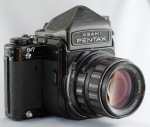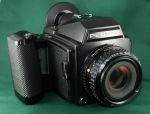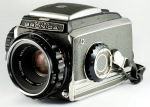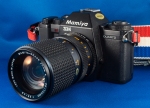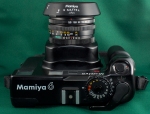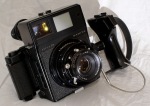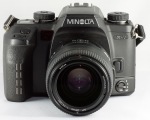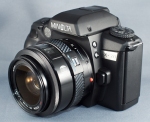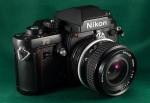What in the world is a chemical camera? Something you hook up to a microscope and use in the chem lab? Something you use in a chemically altered state? The latest mobile photo app to go along with “Paper Camera”, “Fx Camera”, “Retro Camera” and “Pinhole Camera”? Or perhaps something far more mundane and familiar??? Yup! They used to just be called “cameras”. Everybody knew what they were, and almost everyone had one. They came in all shapes and sizes; they even had disposable ones that got thrown away after one use! (unless you were incredibly thrifty and tried to recycle them)
Then along came a new kind of camera. At first these new cameras were unreasonably expensive. The images they produced were sketchy at best. But folks seemed to think they were going to be the thing of the future. Sort of like the first portable phone I ever used, back in 1988. It was the size of a brief case and cost the company something like $20,000. Anyway, these new cameras were called “digital cameras”.
Well, somewhere along the line the future became the present and those new cameras are no longer called “digital cameras” by anyone under thirty. They’re just called “cameras”. But that leaves us with a problem. What to call those devices that everyone used to call “cameras” before today’s cameras were called “cameras”? Sometimes the counterpart to digital is referred to as “analog”. But since “digital” isn’t even used to describe cameras anymore why use an overworked and underwhelming term like analog?
I suppose we could call them “film cameras” but you wouldn’t believe how many people don’t have any idea what that means. Frequently when a curious bystander inquires about my camera and I tell them it’s a “film camera” their response is, “what’s that?” And then the next question is usually, “Digital, right?” betraying the fact that they actually don’t know the meaning of either term, “film” or “digital”.
So then what exactly is the difference between a “camera” (1836-1993) and a “camera” (present day)? Put simply the present day camera captures light and renders images electronically. Light passes through a lens and hits a sensor that reacts by creating electrical signals. Those signals are passed on to an electrical screen where the image is rendered. The prior cameras captured light and rendered images chemically. Light passed through the lens and hit a flat sheet of chemically treated film. The chemicals reacted to the light. Then the film was subjected to a series of other chemicals, the reaction to which rendered a permanent image on the film. Transferring the image from that frame of film onto a sheet of photo paper involved yet another series of chemical treatments and reactions. Photography has always been about light and images, but what used to be a largely chemical process has now become a primarily electronic one.
This website is all about my chemical cameras and chemical photography. It’s not that I’m opposed to electronic photography and electronic cameras in any way. In fact I’ve spent a lot more money on “digital” equipment than “chemical”, but I like the old way. It’s fun, it requires a certain degree of imagination, quite a bit of patience, and there is something deeply satisfying about doing photography the same way it has been done for a very long time and getting beautiful results. Whether light is captured chemically or electronically doesn’t really make much difference for the results, but there are distinct differences in how one goes about making a picture depending on the technology employed. The other thing that makes chemical photography especially attractive right now is the prices. Expensive professional “chemical” cameras can be had for pennies on the dollar! Most of the cameras you see on this sight were purchased for less than $100. Many were less than $50! Some of these are cameras that cost thousands of dollars just a few years ago. Chemical photography is far from being dead.
I’ve owned all of these cameras at one point or another, but not simultaneously. Over the last few years I’ve been fortunate to get my hands on a lot of great cameras. But over time I’ve come to realize which ones I actually use and which ones tend to stay on the shelf. I also have realized that some of the cameras I want most aren’t all that cheap. So I have come to accept the truth that I can’t have them all! Fortunately I have been able to sell some of my less used cameras to help finance the purchase of other cameras I really wanted. But just because I sell a camera is no reason to eliminate it from this web site. So if you look closely you’ll see notes here and there indicating the ones I’ve sold. In the summer of 2012 I sold a bunch of cameras and lenses and replaced them with two very fine medium format rangefinders; the Fuji GF670 and the New Mamiya 6. Then in the fall of 2013 I sold almost everything else except the Pentax 645N and came home with the Pentax 67ii. So those are my four primary medium format cameras now.
Learn more about any of these cameras by selecting from the list shown at the top of this page. Or you can search by category or image from the lists below.
Categorized by film size:
- Large Format (4″ x 5″ sheet film)
- Medium Format (120 roll film)
- Small Format (135 roll film)
- Miniature (110 cartridge film)
Categorized by frame size:
- 4 x 5 inches (sheet film)
- 6×9 cm (120 roll film)
- 6 x 7 cm (120 roll film)
- 6 x 6 cm (120 roll film)
- 6 x 4.5 cm (120 roll film)
- 36 x 24 mm (135 roll film)
- 24 x 17.5 mm (135 roll film)
- 17 x 13 mm (110 cartridge film)
Categorized by brand:
- Asahi Pentax
- Bronica
- Fujifilm
- Graflex
- Mamiya
- Minolta
- Nikon (Sold)
- Olympus
- Voigtlander (Sold)
- Welta
- Wista (Sold)
- Yashica
- Zenit
Quick View:
- Asahi Pentax 6×7
- Asahi Pentax 67
- Pentax 67ii
- Pentax 645
- Pentax 645N
- Asahi Pentax S2
- Asahi Pentax SV
- Asahi Pentax Spotmatic SP
- Asahi Pentax Spotmatic SP
- Asahi Pentax SL
- Asahi Pentax Electro Spotmatic
- Asahi Pentax ESII
- Asahi Pentax Auto 110
- Zenza Bronica ETR-S
- Zenza Bronica SQ-A
- Zenza Bronica C
- Zenza Bronica GS-1
- Fuji Film Klasse
- Fuji GS645 Professional
- Fujifilm GF670 Professional
- Graflex Speed Graphic
- Mamiya ZM Quartz
- Mamiya 645 Pro TL
- Mamiya-Six
- New Mamiya 6
- Mamiya Press Super 23
- Mamiya RB67 Professional SD
- Minolta Alpha 9
- Minolta Alpha 7
- Minolta Alpha Sweet II
- Minolta Alpha 70
- Minolta Alpha 7000
- Minolta X-700
- Nikon F3
- Olympus Pen EE-S
- Olympus Pen EE-3
- Voigtlander Bessa-R
- Welta Symbol
- Wista 45N
- Yashicaflex
- Zenit-E

